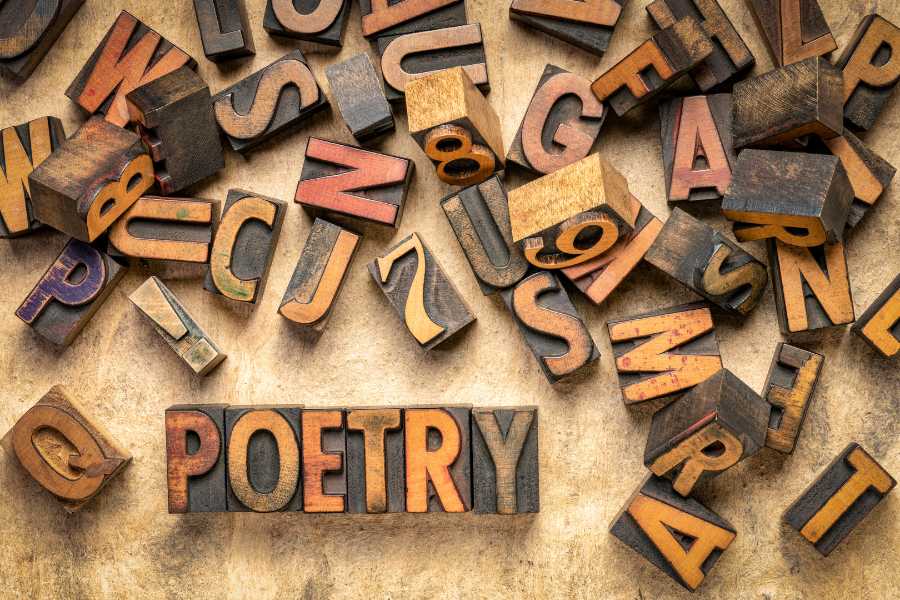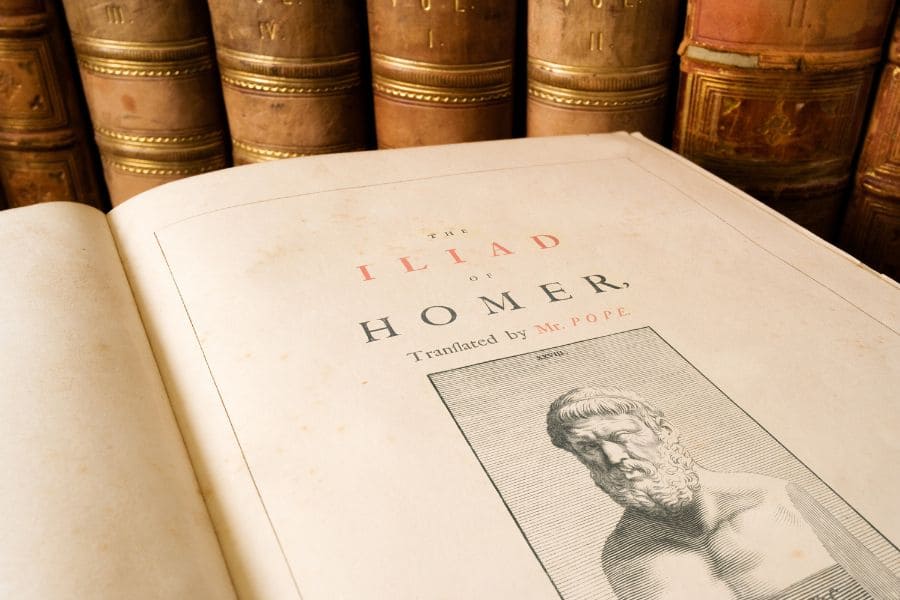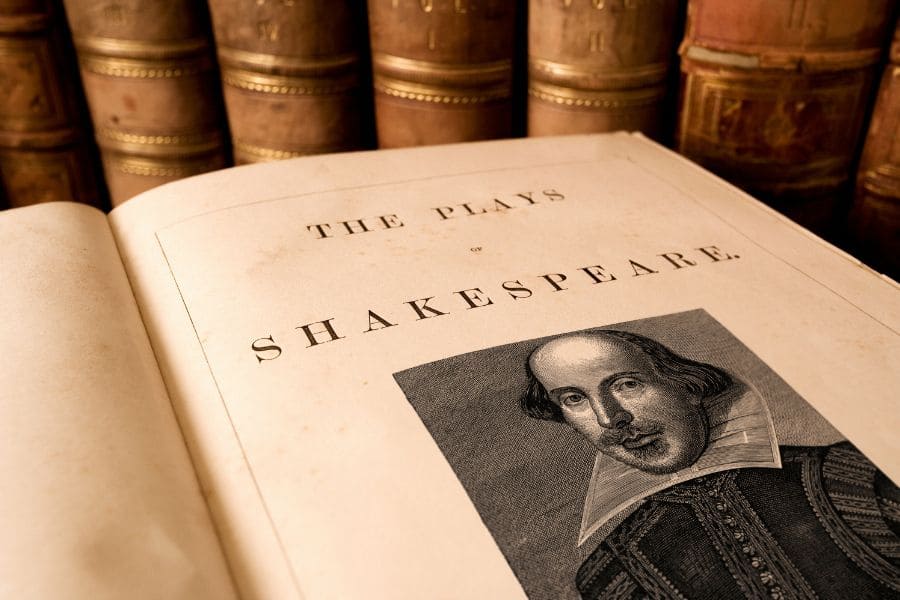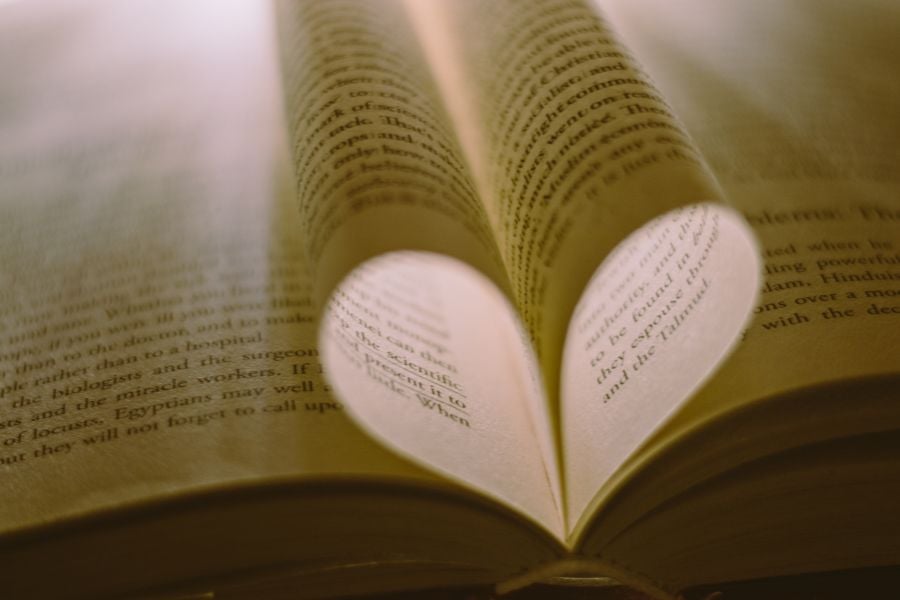It can be uber confusing to come across so many different types of poems and not know what’s what.
Maybe you’ve just started studying poetry and you’re frustrated with all these difficult terms and the endless variety of poems.
Or perhaps you’ve been into poetry for some time but need some fresh examples to inspire your next piece?
In this comprehensive post we’ve brought together all the main poetry forms with examples, and made them super easy to understand.
Let’s start from the beginning — the building blocks that define poetry.

Important Elements of Poetry
Whether you love the structured Haiku or prefer the anarchy of free verse, understanding the elements of poetry is crucial.
Think of these as the Lego pieces that build your poetic castle (or spaceship, whatever rocks your boat!).
Meter
Meter is to poetry what beat is to song.
There are two elements to meter:
- The pattern of beats (syllables) per line. This old Geico ad is a perfect example:
The pig “sings”:
And-boots-and-pants- (4)
And-boots-and-pants- (4)
Each line is 4 syllables.
- The pattern of stressed (S) and unstressed (U) syllables. Stress is where the emphasis lies. Going back to our pig, the stressed syllables are the kick and the unstressed are the snare of the drum.
And-BOOTS-and-PANTS– (S-U-S-U)
And-BOOTS-and-PANTS- (S-U-S-U)
The pattern of kicks and snares combined with the number of syllables gives the meter.
Notice that the first “And-BOOTS” is underlined.
Why?
It’s the smallest unit of repetition.
That’s what poets call a foot. In this case it’s an iamb, but there are lots of different feet. Because there are two iambs/line, it’s an iambic dimeter.
Stanza
In poetry, each stanza is like a separate paragraph or verse. There’s a space between each to mark the separation.
Also, in Italian the word “stanza” means room.
So a poem is like a house built up of different rooms, each one with its own character.
The stanza is part of the structure of the poem. It can have a set number of stanza, meter or rhyme scheme.
Rhyme Scheme
The rhyme scheme is the poem’s rhyming pattern which forms the structure.
Rhyming is achieved by using similar sounding vowels and consonants, often at the end of each line. For example:
“They’re not big. They are really so small
You’d think such a thing wouldn’t matter at all.”
— The Sneetches, Dr. Seuss
But rhyme schemes can vary.
You can have a stanza with the pattern AA-BB where the first two lines rhyme with each other, and the last two rhyme with each other.
You can also have different rhyme schemes for each stanza. For example:
ABAB CDCD EE
Yet, not all poems have a set rhyme scheme, but they all use literary devices such as imagery, alliteration or allegory.
Imagery

Imagery is the use of language, either in a figurative or literal way, to evoke the reader’s senses, feelings or sensations.
Also, it can be kinaesthetic (related to movement) or organic (related to internal sensations and feelings).
So, poets make use of any device that can transmit these sensations and feelings from paper (or screen) to the reader’s mind and heart.
Rhythm
A poem doesn’t have to have meter to have rhythm.
Free verse is a great example — there’s no meter, but there’s definitely a rhythm or flow of sound.
Take this example from My House by Rae Armantrout:
“A vine drapes the fence
in its cool enthusiasm,
stemmed cascade.
My skin
has collapsed in flounces,
in anticipation.”
Despite the lack of structure and rhyme, there’s a rhythm to the poem.
Meter is one aspect of rhythm.
But the combination of stressed and unstressed syllables with repetition, gaps and pauses gives free verse its rhythm.
Tone
Practically all forms of creative writing have tone, and poetry is no exception.
The tone reflects the poet’s attitude and feeling towards the subject of the poem and can be formal or informal.
For example, a poet writing about their sleeping baby will have a very different tone to one writing about the horrors of war.
Furthermore, the tone is set by the choice of language and syntax.
For example the use of comparative literary devices like metaphor and simile, or punctuation like exclamations marks and parentheses.
The combination of all these elements — meter, stanza, rhyme scheme, rhythm, imagery and tone — is the basis for different types of poems.
15 Types of Poetic Forms

Now we have the vocabulary to describe the differences, let’s take a deeper look into the 15 poetry forms.
1. Rhymed Poetry
Any poem that contains rhyming elements can be considered rhymed poetry.
There are lots of different types of rhymed poetry, such as the sonnet or the limerick, which we’ll discuss below.
Yet, there are several ways to rhyme your words:
- Perfect rhyme — the number of syllables and vowel sounds match:
Trees and peas
- Masculine rhyme — the stressed syllables match:
Propel and carousel
- Femenine rhyme — the unstressed and stressed syllables match:
Stocking and shocking
So, let’s look at a real-world example:
“The world is so full
of a number of things,
I’m sure we should all
be as happy as kings.”
— “Happy Thoughts”, Robert Louis Stevenson
2. Free Verse
Any poem that doesn’t have a set meter or rhyme falls under the category “free verse”. It’s popular in modern poetry and doesn’t play by the rules.
Here’s an example excerpt:
“her grandmother called her from the playground
“yes, ma’am”
“i want chu to learn how to make rolls” said the old
woman proudly”
— “Legacies,” Nikki Giovanni
Despite the lack of meter or rhyme, it’s clear that it’s a poem. It’s structured in lines and stanza, and has rhythm to the words.
3. Blank Verse
Some of the most famous poets in history have delighted us using this form.
Blank verse poetry doesn’t contain any rhyming words, but it’s different to the free verse as it follows a meter — specifically the iambic pentameter.
And what’s that? You ask…
It’s best explained with an epic poem:
“Five years have past; five summers, with the length
Of five long winters! and again I hear
These waters, rolling from their mountain-springs”
— William Wordsworth
Remember the conversation we had about the pig and the feet?
The 2-syllabled iamb times five in each line makes an iambic pentameter.
4. Narrative Poetry
Most believe narrative poetry is the original form of storytelling. Its defining trait is that it tells a story and it has no set meter.
Here’s the beginning of a classic by the master of dark storytelling:
“Once upon a midnight dreary, while I pondered, weak and weary,
Over many a quaint and curious volume of forgotten lore—
While I nodded, nearly napping, suddenly there came a tapping,
As of some one gently rapping, rapping at my chamber door.”
— “The Raven,” Edgar Allan Poe
5. Epic

A type of narrative poem, the epic is reserved for stories of heroes, legends and historical events.
Epics are often written in hexameter and usually contain powerful language.
Here’s an epic tale from the origins of this poetic form, ancient Greece:
“Be strong, saith my heart; I am a soldier; I have seen worse sights than this. You, why are you so afraid of war and slaughter? Even if all the rest of us drop and die around you, grappling for the ships, you’d run no risk of death: you lack the heart to last it out in combat — coward!”
— “The Illiad,” Homer
6. Haiku
The Japanese Haiku is a form of short poetry that’s become very popular in the West.
The traditional Haiku is made up of 17 on — the Japanese equivalent to syllables — separated into three lines of 5-7-5 on.
Each line ends with a “cutting” word — a strong sound that creates a natural break. For example:
“I write, erase, rewrite
Erase again, and then
A poppy blooms.”
— “A Poppy Blooms,” Katsushika Hokusai
7. Pastoral Poetry
Pastoral poetry is an idealisation of the country life and the role of humans in nature — think Little House on the Prairie.
It was originally an ancient Greek form of poetry accredited to Theocritus, who imagined the shepherd’s life as the ultimate ideal.
There are many types of pastoral poetry, yet they don’t all follow the same meter and structure.
Here’s an example:
“O pleasant orchard, emerald leaves
And shining fruit the summer weaves
Into a jewel of design
Finer than man will e’er refine;
But not until the springtime shows
Her beauty in the lovely blows
Of pear and apple, peach and cherry,
To prove the world at last is merry.”
— “The Orchard,” John Jarvis Holden
8. Elegy
The elegy is a special type of poem that treats the sombre subject of death.
It’s a personal poem that exposes the poet’s innermost feelings of lament for the loss of a loved one.
The elegy doesn’t have to follow a specific format, though there is a form called the “elegiac stanza” which follows an ABAB iambic pentameter.
Here’s an excerpt from a longer elegy:
“Do not stand at my grave and weep,
I am not there, I do not sleep.
I am a thousand winds that blow.
I am the diamond glint on snow.
I am the sunlight on ripened grain.
I am the gentle autumn rain. “
— “Do Not Stand at My Grave and Weep,” Mary Elizabeth Frye
9. Sonnet

Possibly the most famous form of poetry thanks to William Shakespeare.
The modern sonnet is divided into sections, for example:
problem/solution or question/answer.
The Shakespearean sonnet is written in a single stanza of 14 lines of iambic pentameter, following a rhyme scheme ABAB CDCD EFEF GG.
Here’s the first stanza from most famous sonnet in English literature:
“Shall I compare thee to a summer’s day?
Thou art more lovely and more temperate:
Rough winds do shake the darling buds of May,
And summer’s lease hath all too short a date;”
— “Sonnet 18,” William Shakespeare
10. Ode
An ode is a lyric poem (see below) written to praise or embellish a person’s acts.
It usually rhymes, though it doesn’t have to, and often contains 3-5 stanza of 10 lines each.
In addition, there are three types of ode to consider:
Check out this example from Ogden Nash:
“The hands of the clock were reaching high
In an old midtown hotel;
I name no name, but its sordid fame
Is table talk in hell.
I name no name, but hell’s own flame
Illumes the lobby garish,
A gilded snare just off Times Square
For the maidens of the parish.”
— “A Tale Of The Thirteenth Floor,” Ogden Nash
11. Lyric Poetry
The term “lyric” comes from “lyre”, a musical instrument played as an accompaniment to poetry.
They are the songs of old and as such, they focus on a state of mind or emotion, rather than a story. For example:
“I felt a Funeral, in my Brain,
And Mourners to and fro
Kept treading – treading – till it seemed
That Sense was breaking through –
And when they all were seated,
A Service, like a
Drum -Kept beating – beating – till I thought
My Mind was going numb”
— “I Felt a Funeral, in my Brain,” Emily Dickinson
12. Limerick
Rivalled only by Guinness, the Limerick is Ireland’s most famous export.
The limerick lacks the depth and weight of the more classical poetic forms. Instead it offers light and hilarious poetry in strict 5-line stanzas of AABBA rhyme scheme.
Limericks are often rated 18, so we had to pick carefully for this example:
“There once was a fly on the wall.
I wonder, why didn’t it fall?
Because its feet stuck?
Or was it just luck?
Or does gravity miss things so small?”
— “Wish I Were a Fly on the Wall,” Robert D. Cowan
13. Ballad
You might think a ballad is just a love song — and it is.
But it’s also a narrative poem, often recited with music.
Ballads consist of four four-lined stanzas (quatrains) with a rhyme scheme ABCB.
Here are the first lines of one of the most famous ballads ever written:
“Water, water, every where,
And all the boards did shrink;
Water, water, every where,
Nor any drop to drink”
— “The Rime of the Ancient Mariner,” Samuel Taylor Coleridge drink.
14. Soliloquy
A soliloquy is a poetical monologue, with no set meter or rhyme scheme.
Predictably, soliloquies express the character’s thoughts and feelings, are powerful and emotive in their tone.
Do you recognize this one?
“To be, or not to be, that is the question:
Whether ’tis nobler in the mind to suffer
The slings and arrows of outrageous fortune,
Or to take arms against a sea of troubles
And by opposing end them. To die—to sleep,”
– “Hamlet,” William Shakespeare
15. Villanelle
The villanelle is a unique, highly structured poem that originated in France.
It’s made up of five tercets (three lines), followed by a quatrain (four lines).
But its structure is best shown through an example:
“Do not go gentle into that good night,
Old age should burn and rave at close of day;
Rage, rage against the dying of the light.”
— “Do not go gentle into that good night,” Dylan Thomas
Note the first and third lines of the first stanza repeat.
Now we’ve looked at poetry structure and poetic form, you might be wondering what the point is of all this…
Why Study Different Types of Poetry?
Poetry is exploration in its pure form.
Poets play with the way words feel on the tongue, how they connect or how they cut the atmosphere like a katana.
This type of word-play is essential to developing creativity. It pushes both adults and children into exploration mode, allowing the imagination to take over.
Moreover, it leads to the free expression of deep emotions in words and for some this is the only way to self-expression.
You can channel feelings and process thoughts around traumatic events, which can help you and others heal.
Plus, writing poetry can benefit you through sharing.
People who share a love for words can come together and discuss deeper subjects and subtle nuances.

But aside from the emotional aspect, one of the most important reasons to study poetry is it elevates your mastery of language.
It pushes you to convey rich meaning in very few words.
So, in a world where the written word is becoming ever more important and public, mastering your message and being in control of how you communicate can be your biggest strength.
The contrary is also true.
No Types of Poems Can Intimidate You Now
Now you understand the basic building blocks of poems and how to describe poetry in the right terms, you’re free from the chains of ignorance and boredom.
No amount of poetry forms can confuse you now.
So go ahead and use some of the pages we’ve linked to in the post, or go to your local library, and explore the lavish world of poetry.
It will enrich your creative writing, your imagination, and your heart.
The post 15 Fundamental Types of Poems You Should Know (+ Examples) appeared first on Smart Blogger.

No comments:
Post a Comment